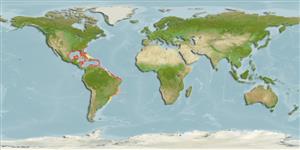>
Ophidiiformes (Cusk eels) >
Ophidiidae (Cusk-eels) > Ophidiinae
Etymology: Ophidion: Diminutive of Greek, ophis = serpent (Ref. 45335); dromio: Named for Dromio (The Comedy of Errors); noun in apposition..
More on authors: Lea & Robins.
Environment: milieu / climate zone / depth range / distribution range
Ökologie
seewasser benthopelagisch; tiefenbereich 51 - 183 m (Ref. 81834), usually ? - 100 m (Ref. 81834). Subtropical
Western Atlantic: USA. off Colombia, Venezuela and Guyana.
Size / Gewicht / Alter
Maturity: Lm ? range ? - ? cm
Max length : 14.6 cm SL Männchen/unbestimmt; (Ref. 81834)
Kurzbeschreibung
Bestimmungsschlüssel | Morphologie | Morphometrie
Rückenflossenweichstrahlen (insgesamt) : 116 - 129; Afterflossenweichstrahlen: 92 - 102; Wirbelzahl: 67 - 69. This species is characterized by the following features: D 116-129 (usually 119-125); A 92-102 (usually 98-100); pectoral fin rays 19-21 (rarely 20); precaudal vertebrae 16-17 (usually 17); caudal vertebrae 50-52 (usually 51), total vertebrae 67-69 (usually 68); gill rakers on first gill arch with 2 rudiments above, 4 developed but short gill rakers below; short, blunt and bulbous head; dorsal tissue of head usually flaccid, inflated; subterminal mouth; dorsal and ventral profiles of body nearly parallel for much of its length; unmarked body; short and unequal pelvic-fin rays, longer reaching under anterior third of opercle (Ref. 81834).
Occurs over sand and mud bottom (Ref. 81834). Reproductive strategy possibly similar to other members of this family featuring oviparity, with oval pelagic eggs floating in a gelatinous mass (Ref. 205).
Life cycle and mating behavior
Maturities | Fortpflanzung | Spawnings | Egg(s) | Fecundities | Larven
Lea, R.N. and C.R. Robins, 2003. Four new species of the genus Ophidion (Pisces: Ophidiidae) from the western Atlantic Ocean. University of Kansas Museum of Natural History, Scientific Papers No. 31:1-9. (Ref. 81834)
IUCN Rote Liste Status (Ref. 130435)
Bedrohung für Menschen
Harmless
Nutzung durch Menschen
Tools
Zusatzinformationen
Download XML
Internet Quellen
Estimates based on models
Preferred temperature (Ref.
123201): 17.5 - 26.5, mean 23 °C (based on 70 cells).
Phylogenetic diversity index (Ref.
82804): PD
50 = 0.5000 [Uniqueness, from 0.5 = low to 2.0 = high].
Bayesian length-weight: a=0.00102 (0.00046 - 0.00225), b=3.06 (2.88 - 3.24), in cm total length, based on all LWR estimates for this body shape (Ref.
93245).
Trophic level (Ref.
69278): 3.5 ±0.7 se; based on size and trophs of closest relatives
Widerstandsfähigkeit (Ref.
120179): hoch, Verdopplung der Population dauert weniger als 15 Monate. (Preliminary K or Fecundity.).
Fishing Vulnerability (Ref.
59153): Low vulnerability (10 of 100).
